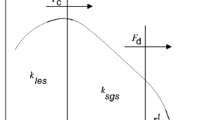Abstract
A transport model for hybrid RANS/LES simulation of passive scalars is proposed. It invokes a dynamically computed subgrid Prandtl number. The method is based on computing test-filter fluxes. The formulation proves to be especially effective on coarse grids, as occur in DES. After testing it in a wall resolved LES, the present formulation is applied to the Adaptive DDES model of Yin et al. (Phys. Fluids 27, 025105 2015). It is validated by turbulent channel flow and turbulent boundary layer computations.

















Similar content being viewed by others
References
Reddy, K.R., Ryon, J.A., Durbin, P.A.: A DDES model with a smagorinsky-type eddy viscosity formulation and log-layer mismatch correction. Int. J. Heat Fluid Flow 50, 103–113 (2014)
Shur, M.L., Spalart, P.R., Strelets, M.K.H., Travin, A.K.: A hybrid RANS-LES approach with delayed-DES and wall-modelled LES capabilities. Int. J. Heat Fluid Flow 29, 1638–1649 (2008)
Spalart, P.R., Deck, S., Shur, M.L., Squires, K.D., Strelets, M.K.H., Travin, A.: A new version of detached-eddy simulation, resistant to ambiguous grid densities. Theor. Comput. Fluid Dyn. 20, 181–195 (2006)
Yin, Z., Reddy, K.R., Durbin, P.A.: On the dynamic computation of the model constant in delayed detached eddy simulation. Phys. Fluids 27, 025105 (2015)
Kays, W.M.: Turbulent Prandtl number, where are we?. J. Heat Tran. 116, 284–295 (1994)
Kays, W.M., Crawford, M.E., Weigand, B.: Convective heat and mass transfer. Tata McGraw-Hill Education (2012)
Mason, P.J., Derbyshire, S.H.: Large-eddy simulation of the stably-stratified atmospheric boundary layer. Bound.-layer Meteorol. 53, 117–162 (1990)
Moin, P., Squires, K., Cabot, W., Lee, Sangsan: A dynamic subgrid-scale model for compressible turbulence and scalar transport. P. Fluids A: Fluid Dyn. 3, 2746–2757 (1991)
Porté-Agel, F.: A scale-dependent dynamic model for scalar transport in large-eddy simulations of the atmospheric boundary layer. Bound.-Layer Meteorol. 112, 81–105 (2004)
Wang, B.-C., Yee, E., Bergstrom, D.J., Iida, O.: New dynamic subgrid-scale heat flux models for large-eddy simulation of thermal convection based on the general gradient diffusion hypothesis. J. Fluid Mech. 604, 125–163 (2008)
Le Sommer, B.G., Xavier, J.M., Antoine, V.: A dynamic regularized gradient model of the subgrid-scale scalar flux for large eddy simulations. Phys. Fluids 25, 075107 (2013)
Taylor, G.I.: The present position in the theory of turbulent diffusion. In: Landsberg, H. E., VanMieghen, J. (eds.) Advances in Geophysics, vol. 6, pp 101–111. Academic Press (1959)
Meneveau, C., Lund, T.S., Cabot, W.H.: A Lagrangian dynamic subgrid-scale model of turbulence. J. Fluid Mech. 319, 353–385 (1996)
Verma, A., Mahesh, K.: A Lagrangian subgrid-scale model with dynamic estimation of lagrangian time scale for large eddy simulation of complex flows. Phys Fluids 24, 085101 (2012)
Stoll, R., Porté-Agel, F.: Dynamic subgrid-scale models for momentum and scalar fluxes in large-eddy simulations of neutrally stratified atmospheric boundary layers over heterogeneous terrain. Water Resour. Res. 42 (2006)
Kader, B.A.: Temperature and concentration profiles in fully turbulent boundary layers. Int. J. Heat Mass Tran. 24, 1541–1544 (1981)
Jasak, H., Jemcov, A., Tukovic, Z.: OpenFOAM: A C++ library for complex physics simulations. In: International Workshop on Coupled Methods in Numerical Dynamics, pp 1–20 (2007)
Kawamura, H., Abe, H., Matsuo, Y.: DNS of turbulent heat transfer in channel flow with respect to Reynolds and Prandtl number effects. Int. J. Heat Fluid Flow 20, 196–207 (1999)
Moser, R.D., Kim, J., Mansour, N.N.: Direct numerical simulation of turbulent channel flow up to Re = 590. Phys. Fluids 11, 943–945 (1999)
Wilcox, D.C.: Turbulence modeling for CFD, 2nd edn. DCW Industries La Canada, CA (1998)
Arolla, S.K., Durbin, P.A.: Generating inflow turbulence for eddy simulation of turbomachinery flows. In: 52nd AIAA Aerospace Sciences Meeting. National Harbor, Maryland (2014)
De Graaff, D.B., Eaton, J.K.: Reynolds-number scaling of the flat-plate turbulent boundary layer. J. Fluid Mechan. 422, 319–346 (2000)
Reynolds, W.C., Kays, W.M., Kline, S.J.: Heat transfer in the turbulent incompressible boundary layer. Technical Report 12-1-58W/PT1. NASAMemo (1958)
Lilly, D.K.: A proposed modification of the Germano subgrid-scale closure method. Phys. Fluids A: Fluid Dyn. 4(1989-1993), 633–635 (1992)
Acknowledgments
This work was funded in part by the NASA grant NNX14AC72A and NASA Leading Edge Aeronautics grant NNX15AN98A.
Author information
Authors and Affiliations
Corresponding author
Appendix: Adaptive DDES model
Appendix: Adaptive DDES model
The adaptive-DDES formulation of Yin et al. [4] is summarized here. The shielding function for Delayed Detached Eddy Simulation [3] is adopted:
where k/ω is the RANS eddy viscosity formula, ν is the molecular viscosity, κ the vonKarman constant, d w the wall distance, S and Ω rate of strain and rate of rotation, respectively.
It is incongruous to refer to the flow as, simultaneously, being Reynolds averaged and an instantaneous realization: reference to ‘RANS’ and ‘Eddy Simulation’ regions is loose terminology. Detached eddy simulation is best described as a length scale formulation, used to simulate realizations. The length scales and eddy viscosity are defined by:
This ν T defines the production term of the k equation in the k−ω RANS model [20], leaving all the other terms unaltered.
The standard constants are invoked,
It was shown by [4] that an adaptive procedure can improve predictions. In their method, the dynamic procedure of LES [24] is applied to the eddy viscosity (A2) to evaluate C D E S locally within the flow. Following that method, define the test filter stresses,
These are used to determine C D E S ; but, in order for the test filter to be valid, a significant portion of the inertial range needs to be resolved. The coarse meshes that sometimes are used in DES may not capture enough of the small scales. For this reason, a bound is placed on the computed value of C D E S
where the lower limit is determined by:
Equation A7 gagues the mesh resolution by comparing mesh size to the Kolmogoroff scale, L k . If the grid is coarse, C D E S reverts to a default value of 0.12.
Rights and permissions
About this article
Cite this article
Yin, Z., Durbin, P.A. Passive Scalar Transport Modeling for Hybrid RANS/LES Simulation. Flow Turbulence Combust 98, 177–194 (2017). https://doi.org/10.1007/s10494-016-9746-1
Received:
Accepted:
Published:
Issue Date:
DOI: https://doi.org/10.1007/s10494-016-9746-1




